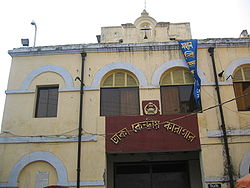
Dhaka Central Jail
Encyclopedia

Jail
A jail is a short-term detention facility in the United States and Canada.Jail may also refer to:In entertainment:*Jail , a 1966 Malayalam movie*Jail , a 2009 Bollywood movie...
in Bangladesh
Bangladesh
Bangladesh , officially the People's Republic of Bangladesh is a sovereign state located in South Asia. It is bordered by India on all sides except for a small border with Burma to the far southeast and by the Bay of Bengal to the south...
, located in the old section of Dhaka
Dhaka
Dhaka is the capital of Bangladesh and the principal city of Dhaka Division. Dhaka is a megacity and one of the major cities of South Asia. Located on the banks of the Buriganga River, Dhaka, along with its metropolitan area, had a population of over 15 million in 2010, making it the largest city...
, the country's capital. The jail has been used to house criminals as well as political prisoner
Political prisoner
According to the Longman Dictionary of Contemporary English, a political prisoner is ‘someone who is in prison because they have opposed or criticized the government of their own country’....
s, especially during the Language Movement
Language Movement
The Bengali Language Movement, also known as the Language Movement , was a political effort in Bangladesh , advocating the recognition of the Bengali language as an official language of Pakistan...
of 1952, the 6 Point Movement, and the Bangladesh Liberation War
Bangladesh Liberation War
The Bangladesh Liberation War was an armed conflict pitting East Pakistan and India against West Pakistan. The war resulted in the secession of East Pakistan, which became the independent nation of Bangladesh....
. However, the jail earned infamy after the killings of four political leaders — A. H. M. Qamaruzzaman
A. H. M. Qamaruzzaman
Abul Hasnat Muhammad Qamaruzzaman was a Bangladeshi politician, senior government minister and a leading member of the Awami League...
, Tajuddin Ahmad
Tajuddin Ahmad
Tajuddin Ahmad was a Bangladeshi politician and statesman who served as the first Prime Minister of Bangladesh...
, Syed Nazrul Islam
Syed Nazrul Islam
Syed Nazrul Islam was a Bangladeshi politician and a senior leader of the Awami League. During the Bangladesh Liberation War, he served as the acting President of Bangladesh in the absence of Sheikh Mujibur Rahman.-Early life:...
and Captain Muhammad Mansur Ali
Muhammad Mansur Ali
Muhammad Mansur Ali was a Bangladeshi politician who was a close confidante of Sheikh Mujibur Rahman, the founding leader of Bangladesh...
— on the eve of a military counter-coup on November 3, 1975 against the regime of president Khondaker Mostaq Ahmad
Khondaker Mostaq Ahmad
Khondaker Moshtaq Ahmad was a Bangladeshi politician who served as the President of Bangladesh from 15 August to 6 November 1975 after the assassination of Sheikh Mujibur Rahman, the founding leader of Bangladesh...
and army chief Ziaur Rahman
Ziaur Rahman
President Ziaur Rahman, Bir Uttam, was a Bangladeshi politician and general, who read the declaration of Independence of Bangladesh on March 26, 1971 on behalf of Sheikh Mujibur Rahman. He later became the seventh President of Bangladesh from 1977 until 1981...
, which had seized power on August 15 after the assassination of Sheikh Mujibur Rahman
Assassination of Sheikh Mujibur Rahman
The assassination of Sheikh Mujibur Rahman took place in the early hours of August 15, 1975, when a group of junior Bangladesh Army officers invaded Sheikh Mujibur Rahman's residence with tanks...
. The slain leaders are mourned by many supporters in Bangladesh today, with the date informally known as "Jail killing day
Jail Killing Day
Jail Killing Day is observed by the Awami League of Bangladesh and many other political organization on November 3 each year. It commemorates the killing of four Awami League leaders: former Vice President Syed Nazrul Islam, former Prime Minister of Bangladesh Tajuddin Ahmed and Captain Mansur...
."
History
Before British ruleBritish Raj
British Raj was the British rule in the Indian subcontinent between 1858 and 1947; The term can also refer to the period of dominion...
, there was a Mughal
Mughal Empire
The Mughal Empire , or Mogul Empire in traditional English usage, was an imperial power from the Indian Subcontinent. The Mughal emperors were descendants of the Timurids...
fort
Fortification
Fortifications are military constructions and buildings designed for defence in warfare and military bases. Humans have constructed defensive works for many thousands of years, in a variety of increasingly complex designs...
at the site of the current jail. During the early years of the 19th century, the fort was renovated, and converted into a jail. Until 1836, the Kotowali Police station was also co-located here. Records from 1833 show that the capacity of the jail at that time was 800 inmates. However, the jail had an average of 526 inmates every day. The Dhaka jail was converted into the central jail for East Bengal
East Bengal
East Bengal was the name used during two periods in the 20th century for a territory that roughly corresponded to the modern state of Bangladesh. Both instances involved a violent partition of Bengal....
.

